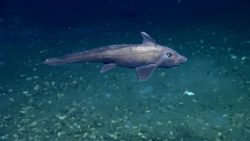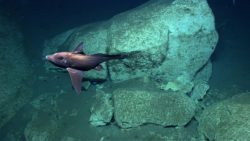
Sea Wonder: Ghost Shark

Photo Credit: NOAA Okeanos Explorer Program, 2013 Northeast U. S. Canyons Expedition
Their name suggests an otherworldliness, but we promise you ghost sharks – which are actually not sharks at all – are more amazing than they are spooky! They are, however, quite mysterious and elusive like ghosts.
Description
Ghost sharks are also called spookfish, ratfishes, or rabbitfishes due to their oddly shaped heads, ghastly coloration, and eerie, large black eyes. However, they aren’t sharks, they are part of a group of cartilaginous fish called chimaeras. They are related to sharks but genetically diverged from their shark relatives nearly 400 million years ago. At least 38 known species of ghost sharks occupy the world’s ocean, the newest of which was discovered in 2009 in the Gulf of California, called the Eastern Pacific Black Ghost Shark.
Ghost sharks have long tapering bodies and incredibly large heads. Their skin ranges in color from black to pale blue to brownish grey and is quite smooth. They have large eyes, oversized nostrils, and large, visible teeth, which give them a rabbit-like appearance, though within their mouths are three tooth plates. On their snouts are small club-shaped structures, atop their bodies are two dorsal fins, on the side are two pectoral fins for movement, and a dorsal fin is at the end of their tail. Their large, high-set eyes give off a green-ish glow due to a reflective tissue in their eyes called the tapetum lucidum, which helps vertebrates see better in low-light conditions.
The ghost shark’s maximum observed length is about 49 inches, but scientists believe they can grow to be more than six feet in some cases.
Diet & Habitat
Ghost sharks are difficult to observe since they occupy the deep sea, but we know they occupy most of the world’s ocean except for Antarctic waters. They live at depths ranging from 200 meters to 2,600 meters and generally stay close to the seafloor.
These sharks use sensory organs on the club-like projection on their snouts to find prey in the dark waters in which they live. Using these organs, they can sense movement and weak electrical fields. Their diet primarily consists of shellfish, mollusks, and worms that live on or under the seafloor. Their dental plates help them catch, crush, and swallow their prey. Larger sharks are natural predators of ghost sharks.
Life History
Ghost sharks are oviparous reproducers, which means they release fertilized egg cases into the water during the spring months. These egg cases are golden yellow in color and settle onto the ocean’s sandy or muddy floor depending on where in the ocean they are. Incubation takes about 8 months, during which time the embryos feed on the yolk of their individual eggs. Before hatching, the egg cases appear black or brown. When ghost shark pups hatch, they are about six inches long and they spend time in shallower water nurseries before moving to deeper waters as they grow. The maximum lifespan of a ghost shark is thought to be about 15 years and males reach maturity about a year earlier than females.
Ghost sharks are thought to be solitary animals as they are generally observed alone.
Threats & Conservation
Chimaeras and ghost sharks around the world are sometimes a target fishery species, usually in coastal waters. They are also caught as bycatch when deep-sea nets are used. With little knowledge of these animals, it is difficult for scientists and managers to understand their population health and create policy to help with management and conservation. Knowing their diet and habitat, we can assume climate change and ocean acidification are significant threats to the species.

Photo Credit: NOAA Okeanos Explorer Program; Our Deepwater Backyard
